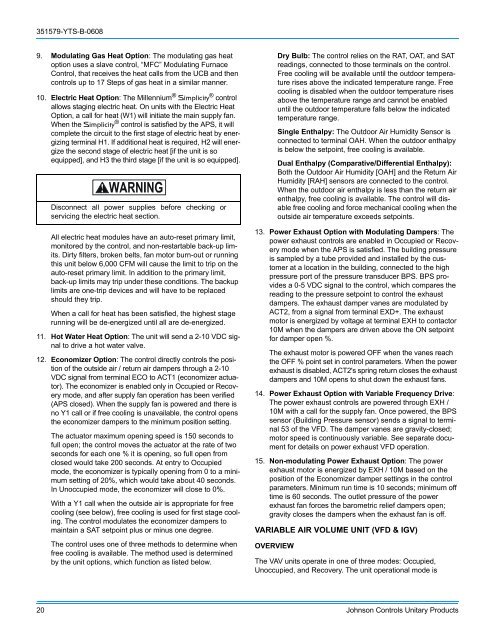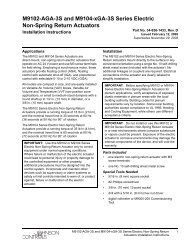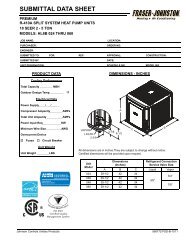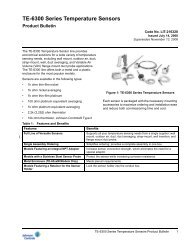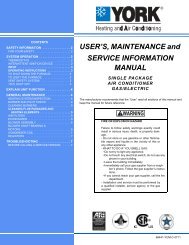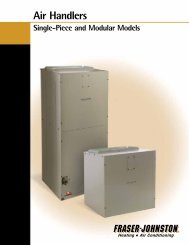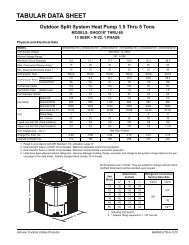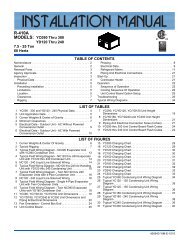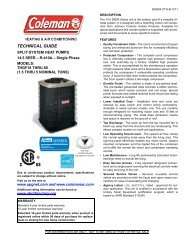analog to digital converter . . . . . . . . . . . . . . . 4 - UPGNet
analog to digital converter . . . . . . . . . . . . . . . 4 - UPGNet
analog to digital converter . . . . . . . . . . . . . . . 4 - UPGNet
You also want an ePaper? Increase the reach of your titles
YUMPU automatically turns print PDFs into web optimized ePapers that Google loves.
351579-YTS-B-06089. Modulating Gas Heat Option: The modulating gas hea<strong>to</strong>ption uses a slave control, “MFC” Modulating FurnaceControl, that receives the heat calls from the UCB and thencontrols up <strong>to</strong> 17 Steps of gas heat in a similar manner.10. Electric Heat Option: The Millennium ® Simplicity ® controlallows staging electric heat. On units with the Electric HeatOption, a call for heat (W1) will initiate the main supply fan.When the Simplicity ® control is satisfied by the APS, it willcomplete the circuit <strong>to</strong> the first stage of electric heat by energizingterminal H1. If additional heat is required, H2 will energizethe second stage of electric heat [if the unit is soequipped], and H3 the third stage [if the unit is so equipped].Disconnect all power supplies before checking orservicing the electric heat section.All electric heat modules have an au<strong>to</strong>-reset primary limit,moni<strong>to</strong>red by the control, and non-restartable back-up limits.Dirty filters, broken belts, fan mo<strong>to</strong>r burn-out or runningthis unit below 6,000 CFM will cause the limit <strong>to</strong> trip on theau<strong>to</strong>-reset primary limit. In addition <strong>to</strong> the primary limit,back-up limits may trip under these conditions. The backuplimits are one-trip devices and will have <strong>to</strong> be replacedshould they trip.When a call for heat has been satisfied, the highest stagerunning will be de-energized until all are de-energized.11. Hot Water Heat Option: The unit will send a 2-10 VDC signal<strong>to</strong> drive a hot water valve.12. Economizer Option: The control directly controls the positionof the outside air / return air dampers through a 2-10VDC signal from terminal ECO <strong>to</strong> ACT1 (economizer actua<strong>to</strong>r).The economizer is enabled only in Occupied or Recoverymode, and after supply fan operation has been verified(APS closed). When the supply fan is powered and there isno Y1 call or if free cooling is unavailable, the control opensthe economizer dampers <strong>to</strong> the minimum position setting.The actua<strong>to</strong>r maximum opening speed is 150 seconds <strong>to</strong>full open; the control moves the actua<strong>to</strong>r at the rate of twoseconds for each one % it is opening, so full open fromclosed would take 200 seconds. At entry <strong>to</strong> Occupiedmode, the economizer is typically opening from 0 <strong>to</strong> a minimumsetting of 20%, which would take about 40 seconds.In Unoccupied mode, the economizer will close <strong>to</strong> 0%.With a Y1 call when the outside air is appropriate for freecooling (see below), free cooling is used for first stage cooling.The control modulates the economizer dampers <strong>to</strong>maintain a SAT setpoint plus or minus one degree.The control uses one of three methods <strong>to</strong> determine whenfree cooling is available. The method used is determinedby the unit options, which function as listed below.Dry Bulb: The control relies on the RAT, OAT, and SATreadings, connected <strong>to</strong> those terminals on the control.Free cooling will be available until the outdoor temperaturerises above the indicated temperature range. Freecooling is disabled when the outdoor temperature risesabove the temperature range and cannot be enableduntil the outdoor temperature falls below the indicatedtemperature range.Single Enthalpy: The Outdoor Air Humidity Sensor isconnected <strong>to</strong> terminal OAH. When the outdoor enthalpyis below the setpoint, free cooling is available.Dual Enthalpy (Comparative/Differential Enthalpy):Both the Outdoor Air Humidity [OAH] and the Return AirHumidity [RAH] sensors are connected <strong>to</strong> the control.When the outdoor air enthalpy is less than the return airenthalpy, free cooling is available. The control will disablefree cooling and force mechanical cooling when theoutside air temperature exceeds setpoints.13. Power Exhaust Option with Modulating Dampers: Thepower exhaust controls are enabled in Occupied or Recoverymode when the APS is satisfied. The building pressureis sampled by a tube provided and installed by the cus<strong>to</strong>merat a location in the building, connected <strong>to</strong> the highpressure port of the pressure transducer BPS. BPS providesa 0-5 VDC signal <strong>to</strong> the control, which compares thereading <strong>to</strong> the pressure setpoint <strong>to</strong> control the exhaustdampers. The exhaust damper vanes are modulated byACT2, from a signal from terminal EXD+. The exhaustmo<strong>to</strong>r is energized by voltage at terminal EXH <strong>to</strong> contac<strong>to</strong>r10M when the dampers are driven above the ON setpointfor damper open %.The exhaust mo<strong>to</strong>r is powered OFF when the vanes reachthe OFF % point set in control parameters. When the powerexhaust is disabled, ACT2's spring return closes the exhaustdampers and 10M opens <strong>to</strong> shut down the exhaust fans.14. Power Exhaust Option with Variable Frequency Drive:The power exhaust controls are powered through EXH /10M with a call for the supply fan. Once powered, the BPSsensor (Building Pressure sensor) sends a signal <strong>to</strong> terminal53 of the VFD. The damper vanes are gravity-closed;mo<strong>to</strong>r speed is continuously variable. See separate documentfor details on power exhaust VFD operation.15. Non-modulating Power Exhaust Option: The powerexhaust mo<strong>to</strong>r is energized by EXH / 10M based on theposition of the Economizer damper settings in the controlparameters. Minimum run time is 10 seconds; minimum offtime is 60 seconds. The outlet pressure of the powerexhaust fan forces the barometric relief dampers open;gravity closes the dampers when the exhaust fan is off.VARIABLE AIR VOLUME UNIT (VFD & IGV)OVERVIEWThe VAV units operate in one of three modes: Occupied,Unoccupied, and Recovery. The unit operational mode is20 Johnson Controls Unitary Products


